Introduction
Aquarium fish are fascinating pets that thrive on a balanced and nutritious diet, and one way to ensure their health and vitality is by providing them with homemade live fish food. While store-bought fish food can be convenient, many aquarium enthusiasts are turning to homemade options to offer their fish a more natural, nutrient-rich alternative. Homemade fish food not only allows you to control the ingredients but also provides a fresher and more varied diet that supports your fish’s overall well-being.
Whether you have tropical fish, goldfish, or bettas, creating your own live fish food at home can be a fun and rewarding experience. In this guide, we’ll walk you through simple and healthy recipes that cater to different types of fish, focusing on fresh, easy-to-source ingredients that promote optimal health. From brine shrimp mixes to fresh veggie blends, you’ll discover the best ways to nourish your aquarium pets and enhance their feeding habits, all while saving money and reducing reliance on processed food. Let’s dive into the world of homemade fish food and give your fish the care they deserve!
Introduction to Homemade Fish Food
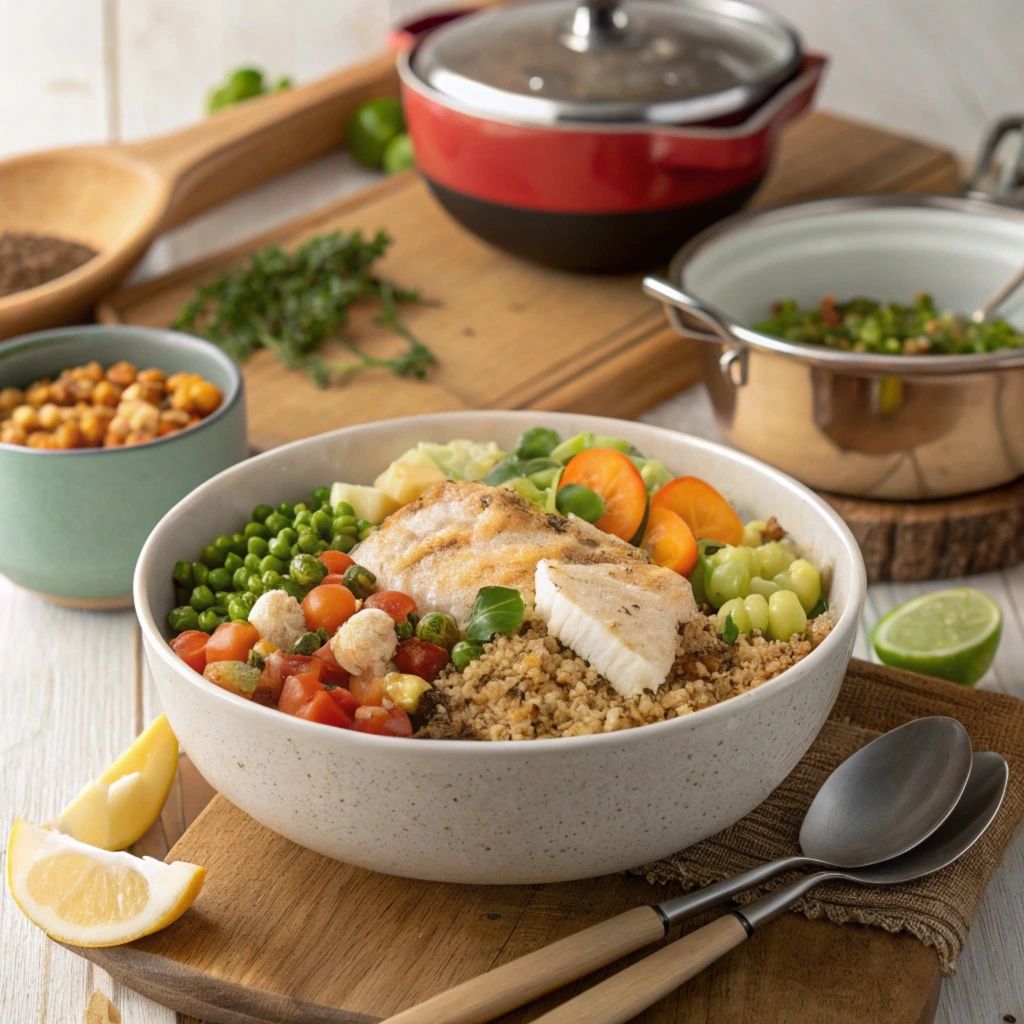
Introduction to Homemade Fish Food
Making fish food at home is a rewarding way to ensure your aquatic pets receive a healthy and nutritious diet. If you’re new to the concept of homemade fish food, check out this comprehensive guide to fish nutrition for more details on what your fish need to thrive.
Why Choose Homemade Live Fish Food?
Choosing homemade live fish food offers several significant advantages for both the health of your fish and your aquarium’s overall well-being. While commercial fish food is convenient, it often contains artificial preservatives, colorants, and fillers that may not be ideal for your aquatic pets. Homemade fish food, on the other hand, is free from such additives and gives you complete control over the ingredients, ensuring that your fish receive only the best, freshest nutrition.
Homemade live food also allows for greater customization based on the unique dietary needs of different fish species. By making your own fish food, you can provide tailored nutrition that meets the specific requirements of your fish, whether they are herbivores, carnivores, or omnivores. Additionally, homemade food is often more cost-effective than buying pre-packaged alternatives, especially if you have multiple tanks or a large aquarium setup.
To learn more about how to make your own nutritious homemade fish food, check out our detailed guide on [How to Make Live Food for Fish: Easy and Nutritious Homemade Recipes].
Benefits of Natural Fish Food for Aquarium Pets
Natural fish food offers a wealth of benefits over processed options. One of the main advantages is the absence of harmful chemicals and preservatives that are sometimes found in store-bought foods. These preservatives can accumulate in the water, affecting the water quality and potentially harming both your fish and the overall tank ecosystem.
By feeding your fish natural, homemade food, you can avoid these concerns while providing your pets with the nutrition they need to thrive. Natural fish food often contains higher levels of vitamins, minerals, and essential fatty acids, all of which play a crucial role in the development and maintenance of healthy fish. For example, omega-3 fatty acids found in certain natural ingredients can help improve the health of your fish’s skin, fins, and overall vitality.
Moreover, using natural ingredients in your homemade fish food can support better color development and encourage more active and vibrant behavior. Fish that are given a nutrient-rich, balanced diet often exhibit more vivid colors and improved overall health, which enhances the aesthetic appeal of your aquarium.
Key Nutritional Needs of Aquarium Fish
Different species of aquarium fish have unique nutritional needs, and providing them with the right balance of nutrients is vital for their health. Below is an overview of the key nutritional components that should be included in homemade fish food, as well as specific dietary requirements for popular aquarium species:
Proteins
Fish are primarily carnivorous or omnivorous, so protein is a crucial component of their diet. Common protein sources for homemade fish food include shrimp, fish, and other seafood. For example:
- Tropical fish such as angelfish and neon tetras thrive on high-quality animal protein, such as shrimp, insects, and fish.
- Goldfish, being omnivores, require a balanced mix of protein from both plant and animal sources to maintain their health and vitality.
- Betta fish, being carnivorous, have high protein needs. They thrive on live or frozen foods such as bloodworms, brine shrimp, and other protein-rich ingredients.
Vegetables
While many fish are protein-heavy eaters, others, like herbivores or omnivores, also need vegetables in their diet. Vegetables provide essential vitamins and fiber, which aid in digestion and overall health. For example:
- Goldfish require plant matter, such as peas and spinach, to ensure proper digestion and prevent issues like swim bladder disease.
- Tropical fish may benefit from vegetable matter such as algae, zucchini, or spinach.
Fats
Essential fatty acids are important for maintaining healthy skin, fins, and overall growth. Fatty fish like salmon and sardines are excellent sources of omega-3 fatty acids, which support healthy cell membranes and enhance the immune system of your fish.
Carbohydrates
While fish are not typically carbohydrate-heavy eaters, small amounts can help provide energy. Ingredients like peas, pumpkin, and other soft vegetables are ideal sources of healthy carbohydrates.
Vitamins and Minerals
A variety of vitamins and minerals are needed for healthy fish. For example, vitamin A supports vision, while vitamin D is essential for bone health. Vitamin C helps boost the immune system. A balanced homemade diet can include ingredients like carrots, spinach, and other nutrient-dense vegetables to meet these needs.
Conclusion: A Balanced Homemade Diet for Thriving Fish
Feeding your fish a balanced homemade diet will ensure they grow strong, vibrant, and disease-resistant, ultimately leading to a more thriving aquarium environment.
Essential Ingredients for Healthy Fish Food
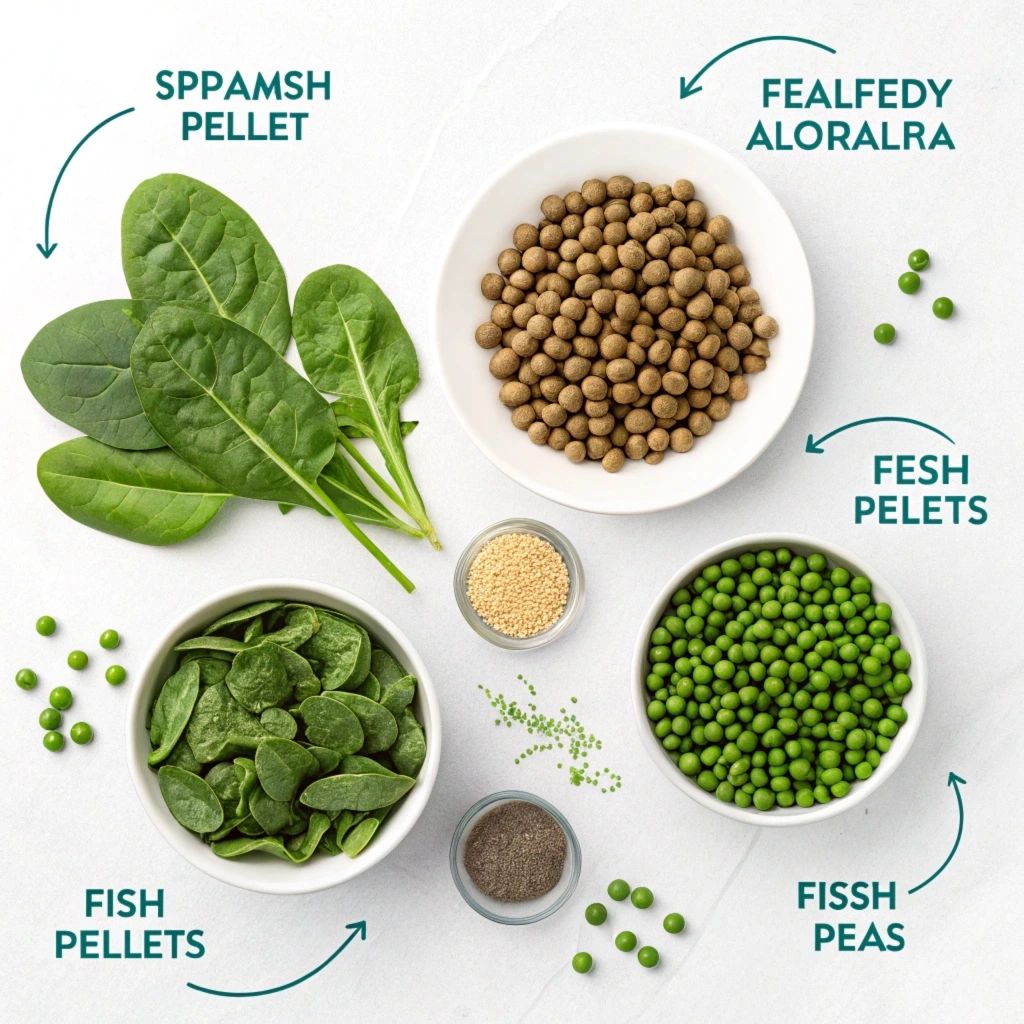
When preparing homemade fish food, selecting the right ingredients is essential to provide your fish with the balanced nutrition they need to thrive. Different fish species have varying dietary requirements, so using the right combination of ingredients can help ensure their health, growth, and vitality. Below are some key ingredients that are particularly beneficial for homemade fish food.
Nutritional Powerhouses: Spirulina, Brine Shrimp, Plankton
- Spirulina: Spirulina is a type of blue-green algae that is a nutritional powerhouse for fish. Rich in proteins, vitamins (especially vitamin A), and essential fatty acids, spirulina is an excellent supplement for many species of fish. It is especially beneficial for herbivorous and omnivorous fish, such as goldfish, cichlids, and guppies, as it provides a well-rounded nutrient profile that supports overall health. Spirulina also helps enhance the natural colors of fish by promoting the production of pigments, leading to more vibrant, lively colors.
- Brine Shrimp: Brine shrimp, often available as live, frozen, or freeze-dried, are an excellent source of protein and essential fatty acids for carnivorous and omnivorous fish, such as bettas, tetras, and many species of tropical fish. The high protein content supports growth, muscle development, and energy levels. Brine shrimp are also a good source of essential nutrients like omega-3 fatty acids, which promote healthy skin, fins, and immune function.
- Plankton: Plankton, including both zooplankton and phytoplankton, provides a rich source of protein, fats, and vitamins for many fish species. Plankton is particularly suitable for small, omnivorous fish, such as neon tetras, angelfish, and other freshwater species. It can be used as a primary food source or as an occasional supplement to enhance the nutritional variety in their diet. Plankton also helps support digestion and can provide essential trace minerals and omega-3 fatty acids.
These ingredients are considered “nutritional powerhouses” because of their high concentrations of essential nutrients, including proteins, vitamins, and minerals, which are vital for maintaining a healthy, active aquarium ecosystem.
Fresh vs. Dried Ingredients for Fish Food
When making homemade fish food, one of the choices you will need to make is whether to use fresh or dried ingredients. Both fresh and dried ingredients have their benefits, but each comes with its own set of considerations.
- Fresh Ingredients:
- Fresh ingredients, such as vegetables (e.g., peas, spinach, zucchini) or seafood (e.g., shrimp, fish fillets), are rich in nutrients and have a more natural taste and texture that many fish prefer.
- Fresh food is often more palatable to fish and retains more vitamins and minerals than dried options, though it may need to be used within a shorter time frame to prevent spoilage.
- Fresh foods should be prepared and stored properly to ensure that they remain safe for your fish. For example, vegetables should be blanched before feeding, and any meat or seafood should be frozen first to kill any potential parasites.
- Fresh ingredients are typically more labor-intensive to prepare and can increase the risk of water contamination if not consumed quickly.
- Dried Ingredients:
- Dried ingredients, such as dried spirulina, freeze-dried brine shrimp, or powdered fish meal, are more convenient and have a longer shelf life compared to fresh options.
- Dried ingredients are usually more affordable and can be stored without refrigeration, making them a good option for fish keepers who have limited time to prepare food.
- However, some nutrients, especially water-soluble vitamins, may be lost during the drying process. For this reason, it’s important to supplement dried food with other fresh ingredients to maintain a balanced diet.
- Dried food can be a good option for long-term storage and bulk feeding, but it’s best to mix it with fresh ingredients for optimal nutritional content.
Ultimately, the choice between fresh and dried ingredients depends on your personal preferences, the specific needs of your fish, and the convenience of feeding. A combination of both fresh and dried ingredients can provide a well-rounded and nutritious diet for your fish.
How to Choose the Right Ingredients Based on Your Fish Type (Betta, Goldfish, etc.)
Different fish species have varying dietary requirements, and selecting the right ingredients for their food ensures they get the proper nutrition they need. Here’s a guide to help you choose ingredients based on the type of fish you are feeding:
- Betta Fish (Carnivorous):
- Betta fish are carnivores, meaning they thrive on protein-rich diets. Foods like brine shrimp, bloodworms, and other live or frozen proteins are ideal for bettas.
- Spirulina can be included as a supplementary ingredient, providing additional essential fatty acids and trace minerals that support overall health and color development.
- Avoid too much plant matter, as bettas are not equipped to process large amounts of vegetables.
- Goldfish (Omnivorous):
- Goldfish require a balanced diet of both animal and plant-based ingredients. Ideal foods include brine shrimp, daphnia, and small pieces of fish or seafood for protein, along with vegetables like peas, spinach, and zucchini for fiber and vitamins.
- Goldfish may also benefit from spirulina to support digestion and enhance their immune system.
- Avoid high-fat foods and limit protein-heavy meals to prevent obesity, as goldfish are prone to overfeeding.
- Tropical Fish (Omnivorous or Herbivorous):
- Tropical fish species, such as angelfish, tetras, and gouramis, typically thrive on a mixture of protein (e.g., brine shrimp, bloodworms) and plant matter (e.g., spirulina, algae, or vegetables).
- For species that lean more toward herbivory, ingredients like spirulina, zucchini, and peas should be prioritized, while omnivorous fish may enjoy a variety of proteins and vegetables mixed together.
- Plankton and small crustaceans can also be added to support the natural diet of many tropical species.
- Cichlids (Omnivorous or Carnivorous):
- Cichlids, including popular species like discus and angelfish, require a protein-rich diet with a variety of food sources. They benefit from foods like brine shrimp, earthworms, and live or frozen seafood.
- While some cichlids enjoy plant matter, others prefer more protein-heavy options, so it’s essential to know your species’ specific dietary needs.
- Spirulina can be added for overall health and to boost immunity.
By understanding the specific dietary needs of your fish and selecting the right ingredients, you can create a tailored, nutritious homemade food that supports their health and longevity.
Simple and Healthy Fish Food Recipes
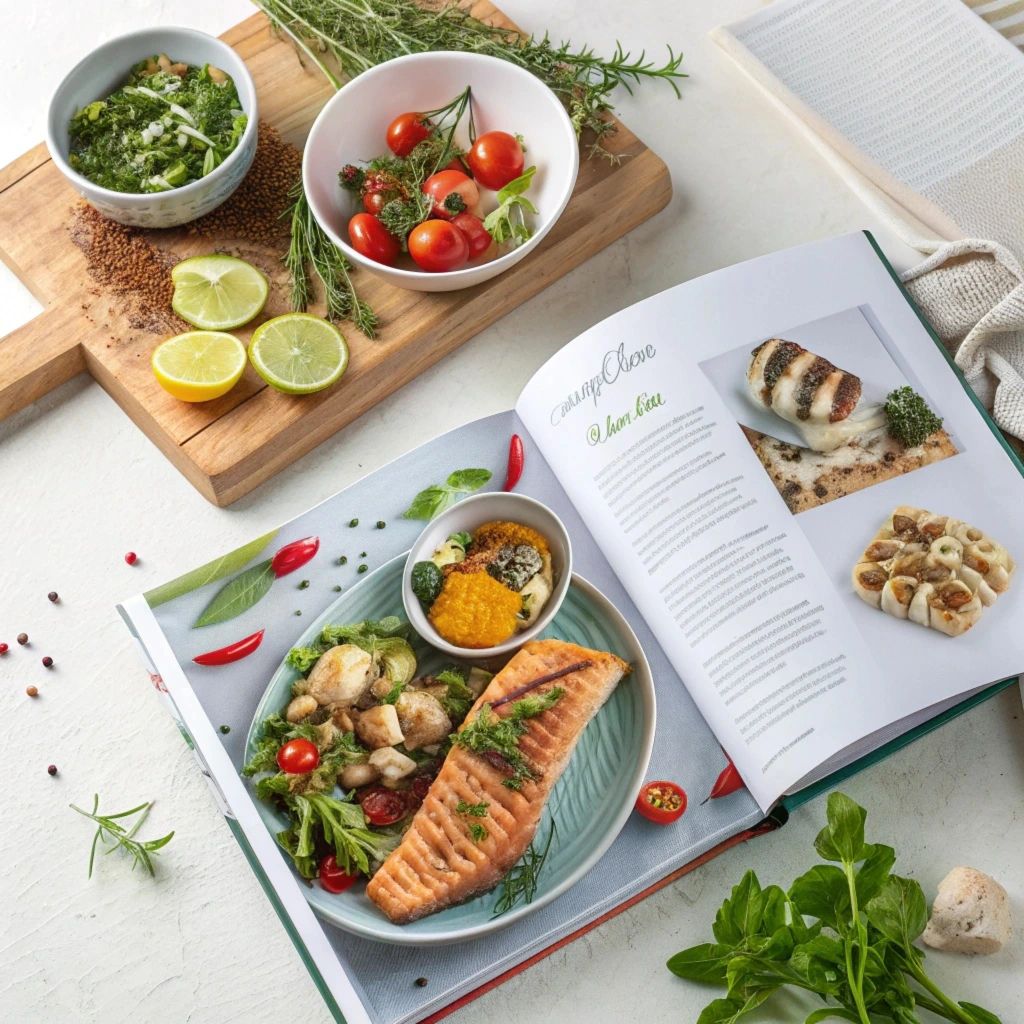
Preparing homemade fish food doesn’t have to be complicated. Below are three simple and nutritious fish food recipes that are easy to make and tailored to the needs of different types of aquarium fish. These recipes are designed to provide your fish with balanced nutrition, using natural ingredients that you can easily find at your local grocery store or pet supply shop.
Recipe 1: DIY Brine Shrimp Mix for Tropical Fish
Ingredients:
- 1/2 cup of frozen or freeze-dried brine shrimp
- 1/4 cup of spirulina powder
- 1/4 cup of finely chopped spinach (fresh or frozen)
- 1/4 teaspoon of garlic powder (optional, for immune support)
- 1 tablespoon of fish oil or omega-3 supplement (optional)
Instructions:
- Thaw the brine shrimp if using frozen brine shrimp. If you’re using freeze-dried, lightly rehydrate them in water for a few minutes to soften.
- Chop the spinach into small pieces or blend it if you want a finer consistency.
- In a small bowl, combine the brine shrimp, spirulina powder, chopped spinach, and garlic powder (if using).
- Add the fish oil or omega-3 supplement to the mixture. This will provide additional essential fatty acids, which support healthy skin, fins, and immune function.
- Mix all ingredients thoroughly to ensure they are well combined.
- Portion the mixture into small cubes using an ice cube tray, silicone mold, or parchment paper. Each cube will serve as a portion for your fish.
- Freeze the mixture until solid. Store the cubes in an airtight container or freezer bag for long-term storage.
- When ready to feed, simply drop a cube into your aquarium. The brine shrimp mix will thaw quickly and provide your fish with a nutritious meal full of protein, vitamins, and essential fatty acids.
Tip: For tropical fish like tetras, angelfish, and guppies, this recipe is perfect as it provides a protein-rich meal with the added benefits of spirulina for better color development.
Recipe 2: Fresh Veggie Blend for Freshwater Fish
Ingredients:
- 1/2 cup of peas (fresh or frozen)
- 1/4 cup of spinach (fresh or frozen)
- 1/4 cup of zucchini (peeled and chopped)
- 1/4 cup of finely chopped carrots
- 1/4 teaspoon of spirulina powder
- 1 tablespoon of vegetable oil (optional, for added healthy fats)
Instructions:
- Boil the vegetables (peas, spinach, zucchini, and carrots) until they are soft and easy to mash (about 3-5 minutes). You can also blanch them by briefly dipping them in boiling water to retain their nutrients.
- Once the vegetables are cooked, drain them and allow them to cool slightly.
- Mash or finely chop the vegetables to create a soft, blended mixture that will be easy for your fish to eat. You can use a food processor or fork to mash them.
- Add the spirulina powder to the vegetable blend and mix it in well. Spirulina is rich in essential nutrients and will help improve your fish’s immune system and color.
- If you want to add extra healthy fats, mix in a small amount of vegetable oil to increase the fat content, which is especially beneficial for herbivorous fish like goldfish.
- Form the mixture into small balls or cubes. You can use a spoon to scoop portions or press the mix into silicone molds for uniform shapes.
- Freeze the veggie blend and store it in an airtight container or freezer bag.
- When it’s time to feed, thaw a cube or ball of the veggie blend and place it in your aquarium.
Tip: This fresh veggie blend is perfect for goldfish, cichlids, and other freshwater species that enjoy a plant-based diet. It’s full of fiber and essential vitamins that will support digestive health and overall vitality.
Recipe 3: Homemade Fish Gelatin for Goldfish and Bettas
Ingredients:
- 1/2 cup of fish broth or water
- 1 tablespoon of powdered gelatin (unflavored)
- 1/4 cup of finely chopped brine shrimp or bloodworms (for carnivorous fish like bettas)
- 1/4 cup of spinach or peas (for herbivorous fish like goldfish)
- 1 tablespoon of spirulina powder
- 1 teaspoon of garlic powder (optional, for immune support)
Instructions:
- Prepare the fish broth or water. If you’re using fish broth, make sure it’s free from any added salt or spices. You can use plain water as an alternative.
- In a small saucepan, heat the fish broth or water over low heat. Once warm, add the powdered gelatin and stir until it fully dissolves. Be careful not to boil the liquid.
- Add the chopped brine shrimp or bloodworms if making this recipe for carnivorous fish like bettas. For goldfish and other herbivores, substitute with finely chopped peas or spinach.
- Stir in the spirulina powder and garlic powder (if using), ensuring that all ingredients are evenly mixed.
- Pour the mixture into a shallow dish or silicone mold and spread it out evenly. Allow it to cool to room temperature before placing it in the refrigerator.
- Once the gelatin mixture has set and become firm (usually in 2-3 hours), cut it into small cubes or portions.
- Store the cubes in an airtight container in the refrigerator for up to one week or freeze them for longer storage.
- When ready to serve, simply remove a portion, thaw it if frozen, and place it in your aquarium.
Tip: This homemade gelatin recipe is versatile, offering a great way to include both meat (brine shrimp or bloodworms) and vegetables (peas, spinach) in your fish’s diet. Bettas and goldfish alike will enjoy this nutrient-packed, easy-to-digest food.
These recipes are designed to be simple yet effective in providing your aquarium fish with the nutrition they need to thrive. Each recipe can be adapted for various species by adjusting the ingredients to meet their dietary preferences. Homemade fish food is not only healthier but also gives you full control over what your fish consume, promoting a long and happy life for your underwater companions.
Tips for Proper Fish Feeding and Storage
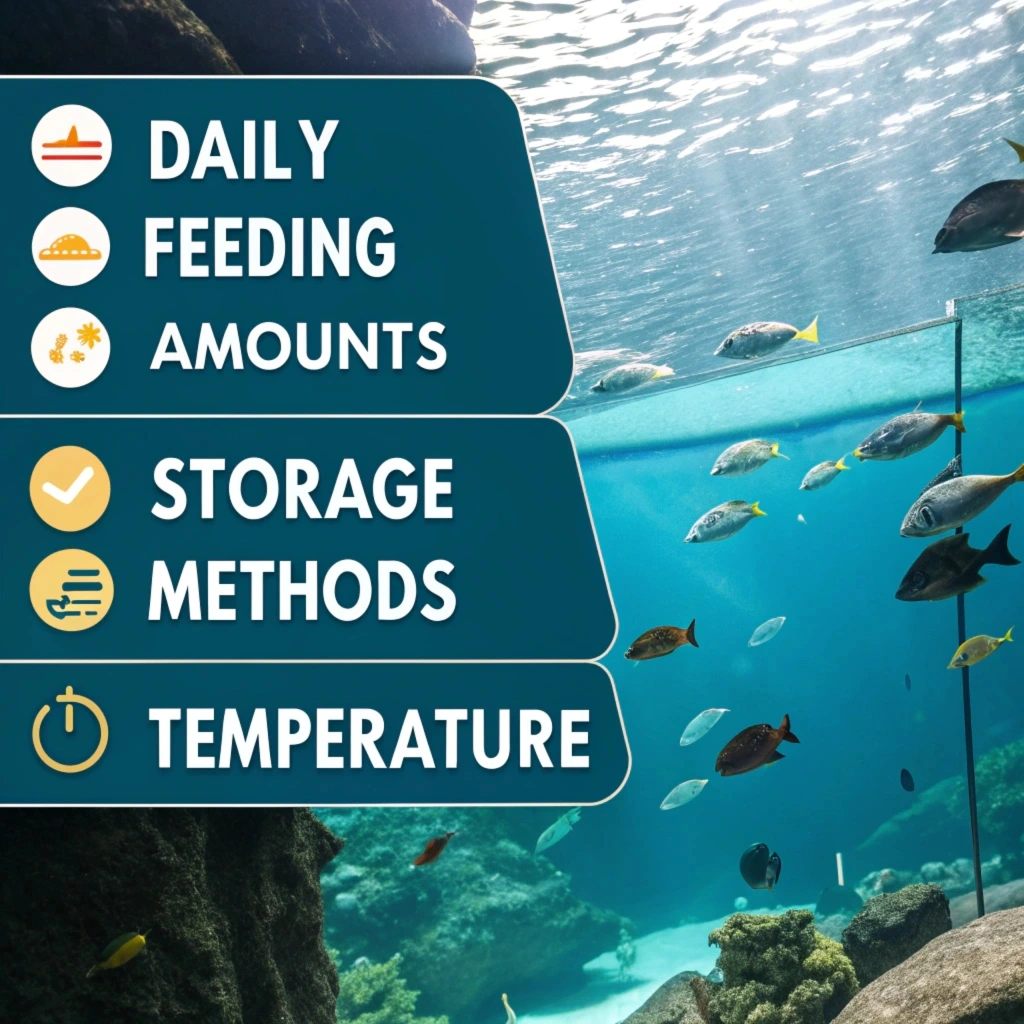
Feeding your fish the right way and storing their food correctly are essential steps in keeping your aquatic pets healthy and your aquarium environment clean. Here’s a detailed guide covering preparation, storage, and feeding frequency:
How to Prepare and Store Live Fish Food at Home
Live fish food is an excellent source of nutrition for many species, but it requires proper preparation and storage to maintain its quality and safety:
- Select Suitable Live Foods
Choose live foods that are appropriate for your fish species, such as brine shrimp, daphnia, or blackworms. Ensure they are sourced from reputable suppliers to avoid introducing harmful parasites or bacteria into your aquarium. - Cultivate Your Own Live Food
- Brine Shrimp: Use a simple setup with saltwater and aeration to hatch brine shrimp eggs. These tiny crustaceans are ideal for both juvenile and adult fish.
- Daphnia: Cultivate daphnia in a bucket with green water or yeast as a food source.
- Micro Worms: Set up a culture using oatmeal and yeast in a shallow container.
- Clean Live Food Before Use
Rinse live food thoroughly under clean water to remove debris and contaminants before feeding your fish. - Store Live Food Properly
- Keep live food in a dedicated container with proper aeration and water changes to maintain freshness.
- For short-term storage, refrigerate live food such as blackworms or brine shrimp. Use within a few days.
- Freeze for Later Use
Freeze surplus live food like brine shrimp or bloodworms in small portions. Freezing retains most of their nutritional value while extending shelf life.
How Often to Feed Your Fish and Portion Control
The frequency and amount of food you provide depend on your fish species, age, and activity level:
- General Feeding Guidelines
- Most fish should be fed 1–2 times daily.
- For herbivorous species, consider smaller, more frequent feedings since they graze throughout the day.
- Predatory fish might only require feeding every other day or a few times a week.
- Portion Control
- Feed only what your fish can consume in 2–3 minutes to prevent overfeeding and water pollution.
- Observe your fish during feeding to gauge their appetite and adjust portions accordingly.
- Special Considerations
- Juvenile fish typically need more frequent feedings (3–4 times daily) to support growth.
- When feeding frozen or live foods, use smaller portions to avoid wastage.
- Watch for Overfeeding Signs
Uneaten food, cloudy water, or sluggish behavior may indicate overfeeding. If you notice these signs, reduce the amount and frequency of feedings.
Storing Leftovers to Ensure Freshness
Leftover fish food, whether it’s dry, frozen, or live, must be stored properly to preserve its quality and nutritional value:
- Dry Fish Food
- Keep in a sealed, airtight container to prevent exposure to air and moisture, which can cause spoilage.
- Store in a cool, dark place away from sunlight. Extreme temperatures can degrade vitamins and other nutrients.
- Frozen Fish Food
- Divide frozen food into individual portions and store in a freezer-safe container or bag. This prevents repeated thawing and refreezing, which can reduce quality.
- Use within the recommended time frame (usually 3–6 months) for optimal nutrition.
- Leftover Live Food
- Keep unused live food in a clean container with fresh water.
- Perform daily water changes to keep the environment sanitary and prolong the life of the food.
- Refrigerate live food that can tolerate colder temperatures, such as blackworms.
- Label and Date All Food
Always label containers with the type of food and the date of storage to ensure you use the oldest stock first. Regularly inspect stored food for signs of spoilage, such as mold, foul odors, or discoloration. - Avoid Waste
- If you have leftovers, consider portioning smaller amounts next time.
- Compost spoiled organic food, such as vegetable scraps for herbivorous fish, to minimize environmental waste.
By following these expanded tips, you can provide your fish with a nutritious diet while ensuring their food remains fresh and safe. Proper feeding and storage habits will not only improve the health of your fish but also help maintain a clean and balanced aquarium environment.
Common Mistakes to Avoid When Making Fish Food at Home
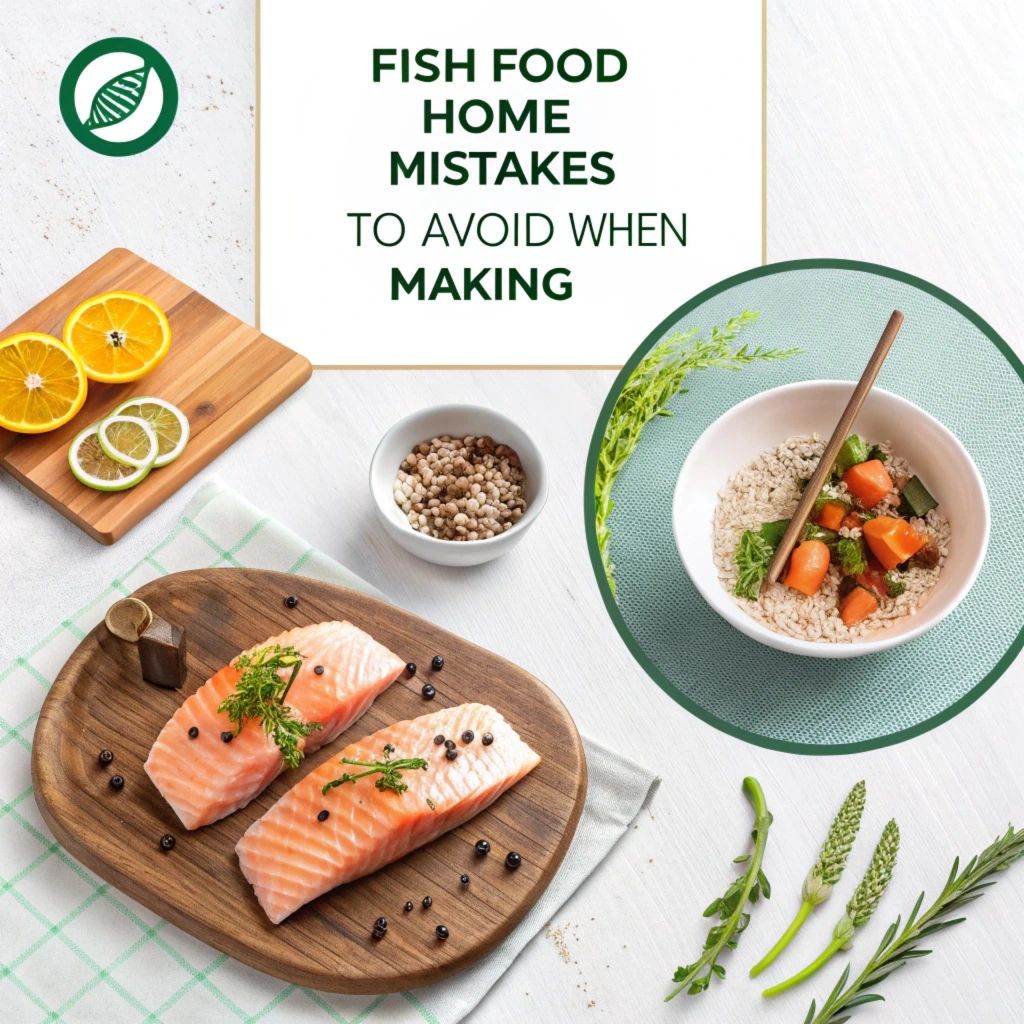
While making homemade fish food can be a rewarding experience, it’s important to avoid common mistakes to ensure the health and well-being of your fish. Below are some key mistakes to watch out for when preparing fish food at home, along with tips to help you avoid them.
Overfeeding: The Risks of Excess Food in the Aquarium
One of the most common mistakes aquarium keepers make when feeding their fish is overfeeding. It can be easy to think that more food will benefit your fish, but overfeeding can lead to several problems in your aquarium.
- Water Quality Issues: Overfeeding leads to uneaten food sinking to the bottom of the tank, where it decomposes. This can cause a spike in harmful ammonia and nitrate levels, degrading water quality and creating a toxic environment for your fish.
- Health Problems for Fish: Excess food not only leads to water contamination but also puts unnecessary stress on your fish’s digestive system. Overfeeding can result in obesity, swim bladder problems, and other health issues, especially for species like goldfish and bettas that are prone to overeating.
- Algae Growth: Leftover food can also feed unwanted algae, leading to an overgrowth that clouds the water and competes with plants for nutrients, disrupting the balance of your aquarium.
Solution: Always feed your fish only what they can consume within 2-3 minutes. A good rule of thumb is to start with small portions and gradually increase if needed, adjusting the quantity based on the specific species of fish in your aquarium. It’s better to underfeed slightly than to overfeed.
Choosing the Wrong Ingredients for Your Fish Species
Each fish species has specific dietary needs, and feeding them the wrong ingredients can lead to nutritional imbalances or health problems. For example:
- Carnivorous Fish: Species like bettas and piranhas thrive on protein-rich diets. Feeding them primarily plant-based foods, such as spirulina or vegetable blends, can lead to malnutrition and poor growth.
- Herbivorous Fish: Fish like goldfish, plecos, and certain cichlids require a plant-based diet. Feeding them too much animal protein can result in obesity, digestive issues, and liver damage.
- Omnivorous Fish: Many species, like tetras and guppies, require a balanced mix of animal and plant matter. Relying too heavily on either one can cause deficiencies in essential nutrients.
Solution: Research the specific dietary needs of the fish species you are keeping. Omnivorous fish will benefit from a mix of proteins and vegetables, while herbivores require more plant-based foods, and carnivores thrive on protein-heavy meals. Always tailor the food you prepare to suit the dietary preferences of your fish.
Avoiding Contamination When Handling Homemade Fish Food
Contamination is another common issue when preparing homemade fish food, and it can pose serious health risks to both your fish and the aquarium environment. Contamination can occur during food preparation, storage, or feeding.
- Bacteria and Pathogens: If ingredients are not stored properly or are handled with dirty hands or utensils, harmful bacteria can grow, leading to infections or diseases in your fish.
- Cross-Contamination: Using utensils or equipment that have been exposed to non-fish-related food items (e.g., meat or dairy products) can introduce harmful substances into your fish food, which could be toxic to your fish.
- Improper Storage: Homemade fish food should always be stored in clean, airtight containers to prevent contamination from airborne bacteria or moisture. If food is left uncovered or stored improperly, it can quickly spoil, posing a risk to your fish.
Solution: Always use clean utensils, cutting boards, and surfaces when preparing homemade fish food. Wash your hands thoroughly before handling ingredients and food. Store homemade fish food in airtight containers in the freezer to prevent contamination and ensure the food remains fresh. When feeding, make sure any leftover food is removed promptly to avoid water contamination.
By avoiding these common mistakes, you can ensure that your homemade fish food is not only nutritious but also safe and beneficial for your fish. Careful portion control, selecting the right ingredients for your fish species, and maintaining proper food hygiene are all important steps in providing a healthy, balanced diet for your aquatic pets.
Conclusion
Making homemade fish food is a fantastic way to ensure your aquarium pets receive the highest quality nutrition while avoiding the artificial additives and preservatives often found in store-bought options. By carefully selecting the right ingredients, preparing balanced meals, and avoiding common mistakes like overfeeding or contamination, you can significantly improve the health and longevity of your fish.
Whether you’re feeding tropical fish, goldfish, or bettas, each recipe can be tailored to meet the specific dietary needs of your aquatic companions. With a little planning and attention to detail, homemade fish food can become an enjoyable and rewarding part of your aquarium care routine. So why not give it a try and offer your fish the best, most natural food possible?
Your fish will thank you with vibrant colors, healthy growth, and an overall boost in vitality!
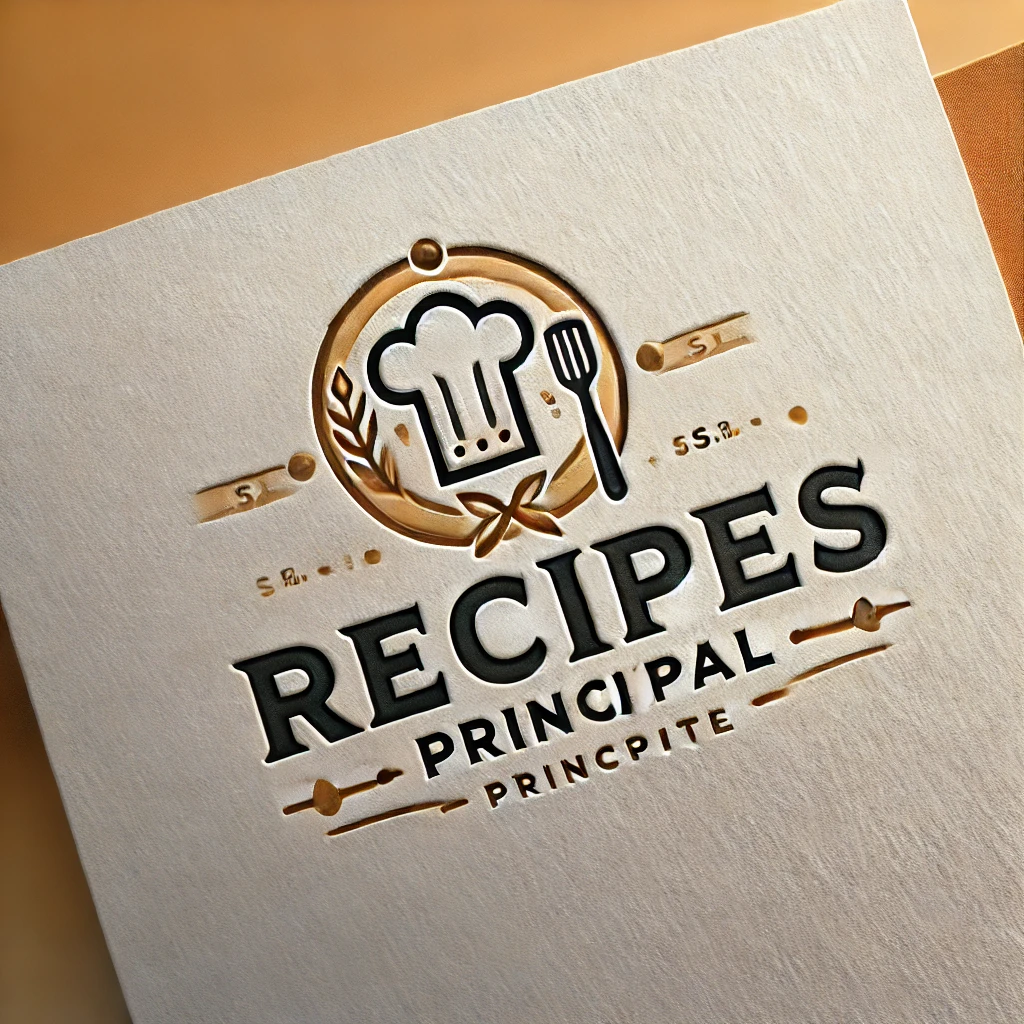
2 thoughts on “How to Make Live Fish Food at Home: Simple and Healthy Recipes”